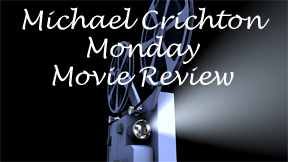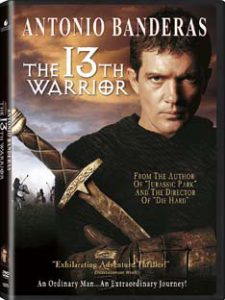“Eaters of the Dead” (1976) took the longest of any Michael Crichton novel to be adapted to film, likely because it’s the least commercial. But in the post-“Jurassic Park” push to adapt all of Crichton’s stuff, it got its turn. The wait didn’t make the material outdated, since it’s set in the 10th century.
And probably 1999 was an ideal time for the release of the movie – retitled “The 13th Warrior” because Crichton noticed everyone recoiled at the original name – as we get decently choreographed battles under the lens of John McTiernan (“Die Hard”), whereas a few years later they would’ve been done with lifeless CGI.
Not easy to adapt
“The 13th Warrior” isn’t as evocative as the book, which is perhaps inevitable. The titular Ahmed ibn Fadlan (Antonio Banderas), who gradually becomes one of the Northmen gang, isn’t as much of an outsider in the film. The Vikings conveniently speak English for audience members’ benefit, and even more conveniently, Ahmed becomes fluent just by listening for a while. His accent is also more Spanish than Middle Eastern, if that sort of thing bothers you.

“The 13th Warrior” (1999)
Directors: John McTiernan, Michael Crichton (uncredited)
Writers: William Wisher, Warren Lewis (screenplay); Michael Crichton (novel)
Stars: Antonio Banderas, Diane Venora, Dennis Storhøi
While the Northmen are gross enough (their morning wash water is shared, and for some reason everyone spits in it), they aren’t as disgustingly ungroomed as in the book. In “Eaters of the Dead,” we visit an almost otherworldly 10th century; in “The 13th Warrior” it feels closer to modern times.
There’s no question this material loses heft in the adaptation process, but it’s not a bad movie. It looks and sounds great under the lens of Peter Menzies Jr. (shooting in always-reliable British Columbia) and with the musical score of the great Jerry Goldsmith.
I like how the Northland is rather beautiful in the early going – where we see prairies and woods – and foreboding toward the end, as we venture into the caves of the enemy Wendol. It’s always a land of fog and horns – classic Viking stuff.
Action over character building
But the characters come off flatter than they should under the pen of William Wisher (“Terminator 2”) and Warren Lewis. Buliwyf (Vladimir Kulich, later The Beast on “Angel”) is the blond-haired square-jawed hero based on Beowulf, and there’s nothing to him beyond that. He lets his actions speak louder than his words, but that’s not a high bar. Dennis Storhoi almost achieves a Gary Oldman-esque quality as Herger the Joyous, the Viking who is closest to Ahmed.
The action gets by as much on mood as on fight choreography. When the bear-head-wearing Wendol warriors attack the Northmen’s sleeping lodge, it’s chaos. This is purposeful; it’s not like one of those fight sequences from a decade later where bad choreography is disguised with pseudo-stylish cuts. We’re meant to experience Ahmed’s disorientation and fear. And indeed, men dressed as bears are quite a sight, even in short bursts.

Later battles are staged more clearly – but with a nice foggy, fiery atmosphere — as arrows and torches fly and horses and men fall. The cave waterfall segment is the highlight; this is not a location you see in every movie.
Vikings being Vikings
One thing about the Vikings’ behavior that does evoke an ancient era is that they don’t spend much time talking, thinking or being afraid. They fight because that’s what they do. And this is why I had a hard time distinguishing the individual warriors (not that we need to); they are all smaller versions of Buliwyf.
Ahmed cuts a different figure because of his Arab dress and smaller horse and curved blade, but even he quickly lives up to his titular label; he only briefly pays lip service against the idea of fighting.
McTiernan almost achieves “Eaters of the Dead’s” otherworldly quality with the approach of the “glow worm” – actually lines of Wendol horsemen brandishing torches. We can almost put ourselves in the Vikings’ boots and imagine it’s truly a massive, mythical glow worm.
But there’s something disappointing about the fact that the supernatural isn’t real in “The 13th Warrior.” There’s a little too much evoking of lore for the villains to simply be men. Couldn’t there be a little extra twist? It’s the same in the novel, but it’s not as disappointing there because there are so many delicious descriptions from Crichton to latch onto.
“Eaters of the Dead” proves unadaptable in terms of capturing the book’s feel on screen. But “The 13th Warrior” is a very watchable attempt, with the crew especially pouring everything they have into bringing us a millennium back in time.

